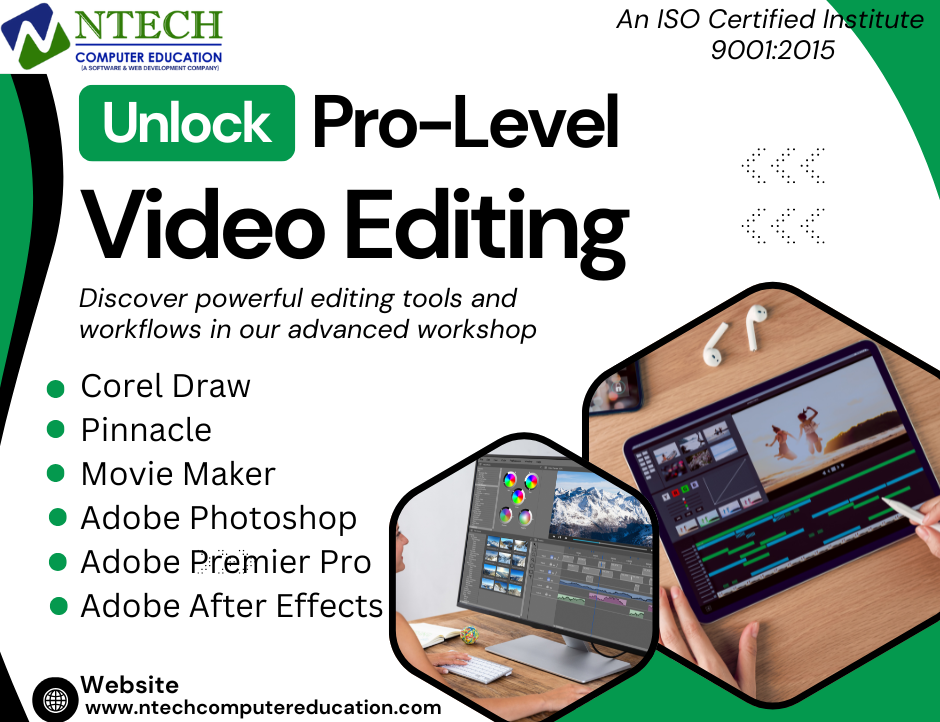Introduction
Video Mixing & Sound Editing is an upcoming and popular career option; this is a key role in the post-production process. As a video editor, you will be responsible for compiling the raw material recorded in a final product suitable for broadcast. Materials may include camera shots, graphics and special effects, dialogue & sound effects Our motivation is to make sure that our students look at them under a different light, shining above the rest at all times. We are motivated by excellence, passion, and experience. As the number of films produced each year increases, we aim to provide quality and skilled professionals to the industry. Our courses are crafted keeping in mind the necessity of practical know-how, given which our students are offered live projects to hone their skills. With each student, we strive to be the best in what we do, by providing the driving force for the film industry.
While pictures tell a thousand words, a video tells a thousand else. Videos are suitable to get someone feeling emotional and indeed getting them to feel angry. With the correct ways and editing secrets, you can effectively tell someone or many people a communication you want to get across. Whether it’s a communication to save humanity or a communication to tell someone about your new music album, no marketing tool beats a important video with matching music.
Video editing is an essential skill for content creators, marketers, and hobbyists alike. Whether you’re creating a YouTube video, a TikTok reel, or a professional presentation, mastering the basics of video editing can elevate your content. This guide will walk you through the process, from planning to publishing.
Step 1: Plan Your Video
Before diving into the software, take time to plan:
- Define your goal: Are you telling a story, showcasing a product, or educating your audience?
- Organize your files: Keep your raw footage, audio tracks, and assets (like graphics or animations) in well-labeled folders for easy access.
- Create a storyboard: Sketch out how your video should flow, noting key scenes, transitions, and effects.
Step 2: Choose the Right Editing Software
The software you use depends on your experience and needs:
- For Beginners:
- https://apps.apple.com/us/app/imovie/id408981434?mt=12CapCut (Mobile)
- Shotcut (Cross-platform, free)
- For Professionals:
- Adobe Premiere Pro
Final Cut ProPro Tip: Start with free or beginner-friendly software to learn the basics before moving to advanced tools.
Step 3: Import and Organize Your Media
- Import your video, audio, and other assets into the editing software.
- Arrange your clips in the timeline in the order they should appear.
- Create bins or folders within the software to group similar files for better organization.
Step 4: Perform Basic Edits
- Cut and Trim: Use the “razor” or “split” tool to remove unwanted parts of your footage. Trim clips to create a smooth narrative flow.
- Add Transitions: Use fades, cuts, or dissolves between scenes for seamless movement.
- Adjust Audio: Sync audio with video, remove background noise, and balance volume levels.
Step 5: Enhance Your Video
To make your video more professional:
- Color Correction:
- Adjust brightness, contrast, and saturation for visual consistency.
- Apply LUTs (Lookup Tables) for cinematic effects.
- Text and Titles:
- Add an opening title, subtitles, or on-screen annotations for better communication.
- Special Effects:
- Use motion graphics, overlays, or green screen effects (chroma key) for dynamic visuals.
Step 6: Finalize and Export
- Review your project: Watch your video multiple times to catch mistakes or identify areas for improvement.
- Export settings:
- Choose MP4 for compatibility.
- Use H.264 codec for quality and compression balance.
- Match the resolution (1080p, 4K) and frame rate (24fps, 30fps) of your original footage.
Step 7: Publish and Share
- Upload your video to platforms like YouTube, Instagram, or TikTok.
- Use descriptive titles, tags, and thumbnails to optimize discoverability.
- Add captions for accessibility and SEO benefits.
Top Tips for Successful Video Editing
- Keep it simple: Avoid overusing effects; focus on storytelling.
- Learn shortcuts: Mastering hotkeys in your editing software saves time.
- Practice regularly: Experiment with styles and techniques to develop your skills.
Courses for learning the best video editing softwares at Ntech Computer Education
Ntech Computer Education offers a Video Mixing & Sound Editing course designed to prepare students for careers in post-production. The course covers a wide range of software tools including Adobe Premiere Pro, Adobe After Effects, Corel Draw, Movie Maker, Pinnacle, EDIUS, and Sound Forge. It includes practical training through live projects and emphasizes creativity and technical skills for video editing, sound editing, and special effects.
Following are the details of tools which will be covered under this course:
- MOVIE MAKER
- ADOBE PREMIER PRO
- ADOBE AFTER EFFECTS
- PINNACLE
- EDIUS
For more details on the courses open the link below:
https://ntechcomputereducation.com/professional-in-video-mixing-sound-editing
Contact us or drop your query on our website https://ntechcomputereducation.com/
Join Us and become a pro in Best video editing softwares available in the market !!

